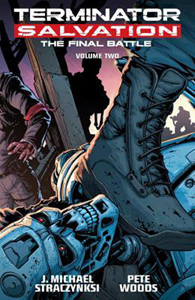Writer J. Michael Straczynski goes deep into the 2029 battle and deep into the idea of the singularity in “Terminator Salvation: The Final Battle” Volume Two (July-December 2014, Dark Horse). It’s an outstanding conclusion of the “Salvation” saga, which got cut down to only one film but enjoyed a robust run of novels and comics. Along with the movie and “The Final Battle” Volume One, Volume Two (which includes Issues 7-12) is part of what I consider the core “Salvation” trilogy.
Exploring the singularity
The singularity – as it applies to human and artificial-intelligence evolution, as well as artificial body parts – is the theory that humans and robots will at some point in the future become a single entity. The theory is the opposite of the initial fear-based theme of the “Terminator” saga: that robots will wipe out humanity.
In some ways, it’s a scary notion that we will “turn into” robots. In other ways, it’s a comforting notion, because it says no fear is necessary; we are intrinsically linked with the AIs we create, and things like artificial hearts and artificial limbs will make humans’ lives better.

“Terminator: Salvation — The Final Battle” Volume Two (2014)
Dark Horse, Issues 7-12
Writer: J. Michael Straczynski
Artists: Pete Woods
Straczynski – ably assisted by Pete Woods’ crisp art – explores all of these notions, but of course he’s coming at the singularity theory from the endgame of the Resistance-versus-Skynet war, which is not how scientific theorists assume the merger will come about. But that only makes it more surprising and fresh; indeed, it’s impressive that Straczynski can keep a reader turning pages with bated breath in a saga where predetermined fate is a central theme.
A big challenge for writers and artists throughout “Terminator” comics history is to find ways to illustrate the inexplicable fact that events happen at different times yet all times occur simultaneously in meta-time.
Straczynski and Woods give a master class of how to pull off this trick in a segment where John and Marcus observe Simon going through the Time Door in 2029 with the mission to kill Thomas Parnell (a serial killer in the employ of Skynet). When things do not immediately change, John announces “The mission has failed.”
A surprising twist
This is dramatically boring in the moment for our heroes, but not for readers because 1, we’ve been following Simon’s battle against three Terminators in 2003 since Volume 1, and 2, Woods delivers back-and-forth panels that give the dramatic impression of the events happening in a linear sequence. It’s logically inaccurate but emotionally true.
In a saga where a main hero (Marcus Wright) and a main villain (Parnell) are human-Terminator hybrids, it’s nonetheless a shocking twist that John decides to have his brain copied into an endoskeleton body in the closing issues. This gives us a striking image for the singularity theory as John argues his case with Skynet that both sides should end the war and team up to rebuild the Earth into something beautiful and meaningful again.

It’s not clear that John will cease to exist if he clicks the “delete” option on Skynet, but that possibility works to explain why he wouldn’t simply delete his longtime nemesis. Another reason is more straight-up rational: “Good” Terminators will make excellent laborers for the rebuilding.
Crisp, logical writing like this is found throughout the 12 issues of “The Final Battle.” Often with time-travel stories, a reader has to allow for a certain amount of “just go with it” story points, but that’s not the case here.
Straczynski communicates the rules and then tells a helluva story within those parameters. Since it covers ground that a filmic “Salvation” trilogy would have had parts two and three not been canceled, “The Final Battle” is among the most essential “Terminator” comics. Happily, it’s also among the best.
CHARACTERS
John Connor: John gets his mind copied over to an endoskeleton body here, assisted by Dr. Serena Kogan’s ingenious tech. This is the most extreme version of the human-Terminator mix that several other stories have tapped into, including with John himself. John gets Marcus’ artificial heart in the “Salvation” movie and he is made out of nanobots in “Genisys.”
Kate Connor: John’s wife doesn’t have a lot to do in this story, although he does live happily ever after with her at the end.
Sarah Connor: No, not John’s mom, but John and Kate’s daughter! She’s seen in the epilogue, along with their son. Young Sarah is a high-tech baby, grown in part from a sample of John’s DNA, since John is a human consciousness in a T-800 Infiltrator body (which looks like himself) at this point.
Marcus Wright: He comes back to life 11 years after his 2018 “death” in “Salvation” because he’s the highest-tech piece of organic tech ever developed by Kogan and Skynet. His damaged parts – including his missing heart – regrow as part of a backup program; it just takes time. Once everything is regrown, he climbs out of his grave and reunites with the Resistance. He can also communicate with Skynet in a way that looks like telepathy to an observer.
Simon: This Resistance soldier’s failed mission to kill Thomas Parnell in 2003 takes up a lot of pages of Volume One and it’s resolved here. The mission is a failure, as John immediately knows because Parnell is still around.
Thomas Parnell: The Big Bad of “The Final Battle,” this psychopathic serial killer is part Terminator and part human. He takes over Skynet from the inside, something that’s bad news for both the Resistance and Skynet, thus leading to the team-up between the longtime enemy forces.
Dr. Serena Kogan: Her devil’s bargain with Skynet – do their bidding in exchange for her own survival from cancer – sets all the events of the “Salvation” saga in motion. Like Marcus, Parnell and (eventually) John, she is a robot-human hybrid.
TERMINATORS
Endoskeletons: Some are on the traditional Skynet’s side, but most – indicated by a bloody streak on the face – do the bidding of Parnell, who has taken over Skynet. The Skynet-versus-Parnell clash gives us rare images of endoskeletons fighting each other in massive brawls.
T-850: The reprogrammed Infiltrator from “Terminator 3: The Rise of the Machines” enters the Time Door here.
Three evil Terminators: These high-tech models’ mission to kill Simon and prevent Parnell from being killed continues from Volume One.
Skynet: The supercomputer is illustrated here by a digital endoskeleton face on a screen.
CONTINUITY AND CONTRADICTIONS
Volume Two continues from Volume One, with action going on in 2003 and 2029 – “simultaneously,” if you will, thanks to the story’s back-and-forth, cause-and-effect narrative approach.
When the John endoskeleton gets his human outer casing, the process is much like a 3D printer. This process has gotten smoother and easier as the “Terminator” spinoff stories have progressed. Human tissue used to be grown in vats around the endoskeleton in stories such as “The Sarah Connor Chronicles.”
When the three evil Terminators’ mission of killing Simon is accomplished, they can’t continue to exist in 2003 yet they also can’t self-terminate. So they go for a walk in the ocean. We’ve seen in other stories that Terminators can exist in the ocean, although it’s not an ideal battleground for fighting. In the final panels, we see a fisherman snag one of the Terminators in 2004. Although it appears inert, prior “Terminator” lore suggests the robot will still function. That said, it doesn’t have a mission, so perhaps it won’t kill anyone. If an evil corporation gets its hands on these robots, though …
John believes he will die in the 2029 war because “that’s what (he’s) been told.” This is what Kate tells him in “Terminator 3: Rise of the Machines.”
Skynet agrees to end the war and team up with humanity to rebuild civilization. John successfully appeals to the mega-computer’s survival sense, which was its initial reason for causing Judgment Day and engaging in the war. (“We were both fighting the same war for the same reason: survival,” John realizes.) Although Skynet is usually portrayed as a strictly logic-based computer that is following its directive to wipe out humanity, deeper questions about Skynet’s motivation have been touched upon in prior stories. For example, way back in the Now Comics, Skynet kills humans because it interprets that that’s what humans want, and it also keeps the war going because otherwise it would become bored.
TIMELINES AND TIME TRAVEL
We see Simon sent through the Time Door from 2029 back to 2003 for his adventure that begins in Volume 1 and wraps up here. Also, Serena completes her devil’s bargain by sending back the three evil Terminators who will kill Simon in order to protect Parnell.
In the last use of the Time Door before the Resistance destroys it, John sends back the T-850 that will pop up in “Terminator 3: Rise of the Machines.” We can surmise this is the “T3” unit because it’s programmed to respond to Kate’s voice, as the Resistance does not have John’s voice available at this moment. But this contradicts the information from “T3” that Kate sends back the T-850 after John’s dies in battle. So although “The Final Battle” doesn’t make a big philosophical deal about it, things don’t happen precisely the same way they did on the “previous” run through this point in time. That could point to a separate branch in the time river, but it could also mean that the two branches meet up again on the main (only) river. The latter theory, which “The Final Battle” seems to subscribe to, is called the “rubber-band effect” in some other stories.
The “Final Battle” timeline operates on the one-timeline principle, in that changes to the past will affect the present, as opposed to creating a branched timeline that our characters won’t be privy to. So when John sends Simon on a mission to 2003 to kill Parnell, and Parnell is still alive immediately after Simon goes through the Time Door, John knows “the mission has failed.”
John himself does not time-travel in this story, but he almost does. (When temporarily trapped under debris, he sends Simon to the Time Door in his place.) Such an occurrence is rare in “Terminator” lore, although we see a time-traveling version of John in “Genisys” and the comic book “Revolution” and the Blackford book trilogy, to cite a few examples.

